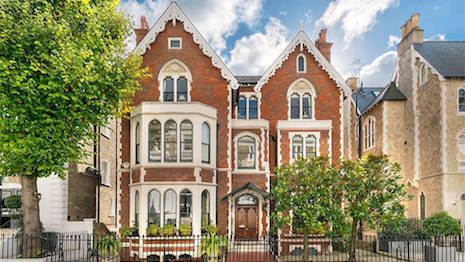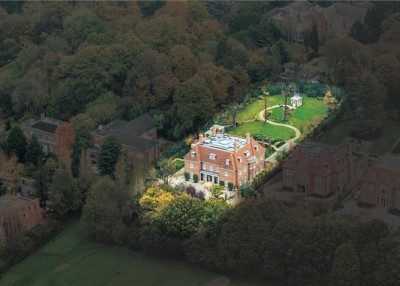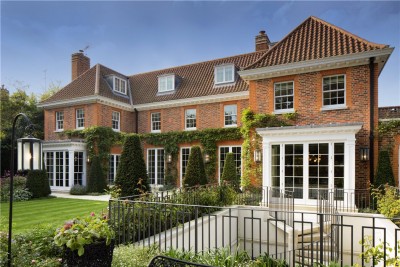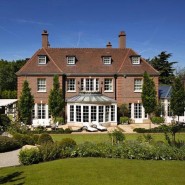The United Kingdom’s impending European Union referendum is causing London’s housing market to falter, according to a Knight Frank report.
The city’s annual growth rate slowed to a mere tenth of a percent in May, its lowest rate since October 2009. Despite the anxieties of a potential withdrawal from the European Union, signs of pent-up demand and a new mayor cast a more hopeful outlook on the market.
"The market has become price-sensitive due to higher levels of stamp duty, but an indication of the Brexit effect is that demand in May has remained subdued even for properties where asking prices have fallen by 10 percent or more," said Tom Bill, head of London residential research at Knight Frank. "Demand was already more restrained as a result of the impact of two stamp duty increases in the space of 18 months."
Brexit
On June 23, the British electorate will vote on the United Kingdom European Union membership referendum, commonly known as “Brexit,” which could see the country withdrawal from the union. The economic uncertainty that could accompany the withdrawal is leading many to wait on purchases.

Kensington, London home
Brexit has hampered demand despite a decrease in asking prices of more than 10 percent. Additionally, the number of active buyers has halved over the last year, a trend tied into larger economic volatility and slowing market but attributable in part to the EU Referendum.
Polls are close but generally suggest the country will not leave the European Union. Experts are predicting that undecided voters will opt to stay once they enter the voting booth, preferring the familiarity of membership to the uncertainty that leaving will create.
Moreover, with Brexit rather than recent stamp duty rate increases being the cause of stagnated demand, buyers could re-enter the market after the vote. Viewings between January and April are up 31 percent compared to the same timeframe in 2015, suggesting interest from buyers.
Still, Knight Frank estimates that for every available property there are only 4.8 active buyers, less than half the number from last year. Accordingly, prices have continued to slow, with growth of just 2.4 percent over the last two years.

Winnington Road, London estate
In addition to Brexit, the election of Sadiq Khan as mayor of London also has implications for the housing market.
Mr. Khan has expressed a desire to increase the number of affordable homes and increase the number of houses built annually to 50,000, double today’s number, by 2020. Additionally, he has talked about tightening restrictions on overseas buyers.
While the impact more affordable housing will have on the luxury market is harder to predict, restricting overseas buyers will likely create a drop in demand and further curtail price growth. The mayoral race led to the more concrete goals and numbers, incentivizing Mr. Khan to stick to them.

Wildwood Road London home
“What was unusual about the 2016 Mayoral election was that enough numbers were traded by the candidates to create a measurable benchmark, which his opponents in 2020 will point to if he falls short,” Professor Tony Travers, a local government expert at the London School of Economics, told Knight Frank for the report. “With that in mind he needs to keep developers broadly onside.”
Ups and downs
Despite decelerating growth, London still boasts the most expensive real estate in the world.
Nevertheless, stagnation in the luxury real estate market of the world’s biggest cities is counterbalanced by the emergence of new hubs, according to a new report by Christie’s International Real Estate.
London and New York have slowed down recently, but less prominent markets that were slower recovering from the recession are continuing to perform admirably. With the post-recession boom over, exchange rates and a host of other political and financial concerns have shaken up the market, creating opportunities and challenges heavily dependent on geography (see story).
Overall, prime residential real estate continued its steady climb in the first quarter of 2016, according to a Knight Frank report released earlier this month.
The index increased 3.6 percent, within the 3-4 percent window observed every quarter since late 2014. However, this is a result of a handful of booming markets rather than stable growth across the board, meaning the 3.6 percent number obscures the fall of some markets (see story).
"Despite the looming referendum, there are signs underlying demand is strengthening as buyers drop asking prices to reflect higher transaction costs," Mr. Bill said.
{"ct":"y5PItM+yyBX9K9Wb+AJ+1VlzKfu+uwe5UJwJgzJd+U5Als7NManrRJ7z2fZnf5KfxwQGUq\/3JS7ZxkM+WuvNDUz+3rxXE1k9H7O7SQAUoz5DndMoHlFde813tIUHNlY\/4Dh\/iq2lvsj+BgI1lWOMM4u9Puzr1\/Wftndoby7qs6FR\/H9XIpihVRLMCps3bwPPOLEyimjhQZZcWfWMKUDKCNwquLReUursuCl+OUJusBVHcLnzKE6xuzxFo1nXM3chBlEJtpNb\/rz\/6j5NCPzvi6DGLlhhdyrm9N2DbFftND6l5V6aquR6U0RGmqYihIEu3Hpg\/eYOy1qhqAmO7KIcbozVmlXkpeBZtmbxTPToy+e+XceuJOVsEtSFGipDg8fEbWcA+cEzmMOc8TZjc6OKPlQM3g14LD729q78L7SpT0Ic8YZjedKrToFL70rTsRYqyZHgQ3Wgp8NhN6TFatRMUfLCodrVKWfHjuF\/kBDj8jh4euDNOd37itI3g9cu4RK9k5TJEeO6OTetB57V0EB9c+W2Lb7A+bzAcHz0oh81d5QaROJGIuUNP9UD1YGbgZoIu7fbWahqHeeASv3Ax84K\/ZrIah0Ze9bzNeB+Y6xwhnjxsNxACBFoK62mUFHrETCF7oQB1VWQF372Jjf7RUjrMLdh4xmXwsynpqQ06TTc3hi\/nVl1n11rZI1GK7FnjWCgeWkJs0TpGGtjbfnkUB5XraN8UU6E4GlMtkz3dAU5u4sfc1fzG9W2gNKZUORcMSSGyDF\/tmW+v5FRf6CDLp1wKUHYt4sPgnZq4JEXklwapVctzRs\/CYHe+8bgEJpKfW+M9AUM0rXKSmPSXHcK7mDLxqtlzSRriK0l3ETokwtiD8ZFOHguEbw2Bao1IXNla2\/V\/tQhtc4KKRLdMLmMtZxe2Zta6A05BbtxcVV2qFwVCp41eCsEhoL4SChCcd0uGxdomZg6iFZcTjVtmz6l1AuyN2PV2IhI5tyJV4lmkaLHE\/qsBf0sOiaMZXjSys55Phui0n4srNy33wki8rsxQVU+x1fZAGRPiNRemC\/GeZZXBRjq2xN2HceymyexOanb\/CWICjDaIAwe8NPP0twvG9bUla2pgvTyB9p852Lk8Ja3KaIgiSe9cEnCDdKrwx13sSUl\/Wtq7K4hE9CicrP76ktnHtqdY\/0MO6oBObos9ozkoRsGP0s9vg7sO7qWmfbCgq3BImj7LDIWsVspjRKiLxwlO4n0JcdQFEYx7kofTCJOKGUWSbnZEKzv0gQ0hYQt+U1YupFFbAsalLj4Cikf9i4xF\/bdhpHc818I\/GGWw6v3dyj9dq8ukomgnVBup84+Usy5e9NL8gjn8n64mtpRzqwdqvS7+kJpQxjvthjYBJdY8DMU23MxQhkUKu7oy+uagXwyg3wbsY4ovueqIkZLZ\/gOKgLMx\/tL23la1LyWrN05BWOFkpo\/\/mp7snlSw5PEngzCvpO8ngO0I4J5xlJf1nMiNbatTQBYL3TzOYE9ZPZXd7WKJMuR6PxgpHpz7g1pXxdbTRED+hoGcWI3lcuEe4RXiSU6lUJgQCK2nPHk61uT0j2no5fkmP7dAS1LftHGskE9RpXRGjWN8EXCnk4BudJJJFRVHQ\/TET+NeZq2JrglqxcDHFAmfno7+XLEdhS+q59c0UNYJEt7\/BOIr0dkBAAGkMvanh6Lapn0UFFbzczZXUL1CTWKPiZ7plVbXOlv\/2I5E36q73XYIjvxs+D7GLOgt2RO6OWeKJs8OieTzEAI7P5VslsTB2IW+u4TBPzdPP5blR4+qjj2KIfb5CsjOp+dzstnQA0WONHQMgfCtHYoNK6IasoLwEDSFo0FJHQma3lDGJlTzVoux3UqoVXTxvU8MrHqP9pswyxjH\/YT6s1tN7peIHFpjgeSYNi4soO\/dJI+uDo4G67giUwnyxD4TSnPxwa2F8fCR8iw2wzI3BZ3GZ\/BE7zcbpQ4yw4A255SXV3x5Ab+9KdpqecKjyqGV2L8zyvKb8foFaTUjdLAmPupIg457Y5\/ecHwbZNspb1PnOv2gh4mgp5S\/MR+tMwTWEdFupzKmY5NxgW\/LB91DBIwodt\/ayBc7383SoP5rg+iW6\/yBKbxymTwuz24dDI41okZDzN\/tgAhQ0c5VwxHPRoiZ9+vDdfs8YwRIpev03Gbl62PABABa3A5unrcZDRgcTmilxoJL9B\/VWOzIwkHFi65BhdPdtpjOzL879NrwTNWCZlEbWRJaYl+ZUNffX9tJ8gewG+Mrx5qN3MBy3pQm5\/fbbte7udzr5ovLLhgNS236uYbIJ7abgFD2E1EvCiVVInJOFkAz3ZGPPDmn73NL1RmKr6aGDoW3liAzubmygAOP9WAXTrWOSERDIfWm63WbCra6xM42bRgdCLWaQKH3QcyoLwsfhPuGUGqyH8AlVXu4TF7A9b4P9BXctN19gDXQXP4EwvxdIfQpGKTwPmpru1lJVY632Av3ttQ9SoVggZo3vyK96vRK3SpjG6p6yzJ3DGGUEAEvmsbapAtQE1x9r8MrYnai405hFdwAHtGZnBRimPl1Stgw7NvH85ABHFt920ogAIa+4Lwdmz9DG57BirS78TrCLJVemu5htnD9Hyv\/RGBFr74TnlggLRRzURjTP2Fkbss6tJBXuXsKlI6M7Pm53Oe8nqmGaFpefeH+IOlptYip1ajC\/bSuCPT6raYEmEocdlQ3p2TeZdP8935CHfgZMiQ4tJHDekokiTXMtVvRXfwkiYQAQgSK2rvGSu8PxKqIlUgt8rPdjFjYf4qDFzvlxMhhGZMO41dp3v5Gt843Kns0f\/c7aNnMtNKyWsNElSeOVl9b5qwGNfokE3H2PFRgMl3kgCxgYUfAPc2iVSYghrGEayExP2Xm0Z6jGfee3wsSO2dGvqEHnqYSoYhjxtYH3cMpqhnr\/\/3iIYm+RYH1vL+4bwH96kMhkSKENIKHCxi\/dm1Lf2hcYiDo+jVHOwgG59JVUTQzP4oF4WddAhypvpYDq4pH9B6dXLCrWSIUXO+UzhHhOinUz6QTRj+7UISfPnVxasReHpGlLw1vRQbMB1pxVrjLgxxP5YfbmgsRs9nGqHAP\/oJ1WlFNiDv2xS+9S++s4kE9oZIB605cGAixhK7jE6TRHStcn0gqaP8Rc8Af15w91OMyKw1yhix3n+LRICo\/LDOm1rM\/We5oP5ec7vds0QKgu5Cd8PwYZfl6Sr0mJDygkspUhCm0mZHvtwqqZGEJh675UbFsbuADXX6MYyEqlgSL+Vs0uvKaiA+c+2TsuvEyUOM8h+AYB+gOfm5xsHo3GzuZ8pHFR16FVw+jHADCO3znttQV4rPrDtEIUXzbsI\/71l1VsCQLx2F+GHSduA3PUjwFWlhzL1xKuzyq\/NhV9f6sGCIWBGvb1jRWVjLd+kdAbIjocmN9MjUaNL9205w05ujP9If3Ha4ilD5S28nvokGcbVykAhhVBHSJMhtJHBP6\/dLmuZBDzgd\/QCccwMcYewtgNhbo7LpE2Or+irnuzMIHCPjYcKw7aaQPHDsrMo9IDkdepUZbzbtd5WBZUQsp4z8a6C3LRnnfqK\/9o9eSgbtkZ2WCxwsWcRUUZR7P++BTbwdJ+y8+tb6NPQfeMkZ14VcnbWCMGJTMR3U0D6DEZMYAw1wpinABH7\/\/n6+vXP14fZCFSwjsrmy9IsSZM5DLOy+UfVNCW+VZsM8ZM3FYWgIEIB6B2CbM1lO0sAw0Og2CesgGKpzcL2J9oAvr4E7f2l7B3p\/Cedmi6lcH1yT\/\/\/C9rcwPxKXJb1BzRwQSxHqAfheJq3MRMSITETvo6zU6qiJzdHoqginZxsk3g3P9qQKYOcx42SDJ49kLLLbkFV5WkYq6ufLtMJhsrsm+cIJyCoDolH+4QcV0Gxd\/JzwP2u9faoPp+Lsgp6cP4077vkDhsmAX2f+RmdqKFCuB5X2InByoTN3wNjfHef4G0B4+KgTHC7zlHNlQk+pV7Ol1qcxllT6664Kyn3c2TPK\/UeX8ivGhOwuwHBZMcjXlAHQaHNQWkSqpxGIy5mqYw0D6EKVPSeX9s1sKF5aNwVdrVlqIEvhy0HTty+RnJFyFU2NW4SQgKGLuyqoWm6qYvH9+v7qtRYNfZZmtJtrDKHYz9gwjzVXk6QPajuHks3zbjLcLeB7jph7rnQbN7EGkvgdKR68bCk\/GNNkuVmI\/Np\/w6W5sAAnvczwe5Sz49gTjEmWV\/futexMAb+T0vAuwHtzwUWE5d3y97M6SF1Hkl2qnSOcwQFr\/q3gl9\/UMmbfz4JnjwGp7ir++KU7UOdNQBP0TgOAb0E7h1SpVawKw6PzG9NOjgr0PkuVVbaBaay4MckMbdU2cHImqQXVbVeaMi5qfVk2MLYIDLl\/JgZNukvVmrZgV9jb\/5nXdi7J990gB2Nw1Cxf0u+24mjsz\/plRmjqCkKrOXIglFug\/tbQt\/jfkWXjmwsQjVG15qFQlyQY+DTxpkkWaC6C9qsg8nV03j2QlsslZ90QCJprhEgni5TQlcUIc9P7zy8oAeW010gHNE\/+m7zOFNHzJzbGn6Q\/Zalj1Oj0DUoX6I04LDN+517vOaOXep1pfpqI2RnFhg71mdxmnYbtgQMorbtHvasAIuVMiNVX6TNoH6voUX1GEtcIh+80E2PtFhYiLh2CdhhS2W4fH\/Uh\/TN1xrY\/t3NOL\/ed1aOUC7S3yP1qfq5TzZRwMYcFJfOF5p\/xIXtV73tz+eYlYlgLMrBaWzkqtxF5YRjLEtKqJgTzuFmCkqXLWEy6vLHFF5cQwBG4+nx7c+sXLP6leflVgnckH1+kMxJW33GKiCcaTTVb7ttWTO30saoyPkCViTtV4vPlPLwdI4xolhBiSv1DMZhtn23KEEZxJXV3fIk88TFg2cF9JfBBgUCmZnum9lEFZvrgpEkFnttm9mRW5v8ik0kiuRvcX2eETQdAavg+S9r7b\/3mUC02o2+oFNmj2lfp5L888QkYm7TK2600b\/lCDH443A3Sr9AGYbku9LhFe0zhMqje3egbc2a5SAxazSPzJpX2+DShtKwBA4qMGr1vNtE5s9aWYnFZZOdPFoktY+DiNHa23H\/v5Og8zFg1kWCnPr4YvYlyu7P+VVCdjQXr0gjH6lCQ6+uNPE3EQwmHmfXGpwQFUk1\/Wgxd2D0yxKSkpTeHxGSrzgZyDRgQk2cxNnhiqSTKLIBTOry7X14odl47YgnIRCoHpOL1XgKndp12SnJTDjmV59TAUuJCYdJ2LedbZJ7IHPc43ljWKuaBqSQvmC\/ufVlLFu02bGIjvQFoMmRxjQ7CDTgQ1zU6nFLqv5ZVlKF\/UwYhnYkT7AeBRH9zWia+xvy0O8SXfSf+3K5XHRw\/T0ahx2Y941MfzrVTJ18a1if3DWDn7MNQjsWnE4wK6718WH70hSQZ+S+VPCLRkr\/bcSBYgUTRu6u13C\/VckDLYOG8\/mV7SB798S7w8JsOkHt4D8QU5Mm9qbEXGDUDc9eLTfAn6paEdqcx10OU3rBd8dQCJY+9LjFT1WMbLcmY5mxZiGC2kA3duDI4tSeaN6Xp9wbQghzQ0yrsfoRBXepDr+GB7\/\/REbZgS01jyMtFCZoW4QT+D0OfKxasMtxlDmPPdL0Cnewaccwr5EHr3BGRz4eSc4rzS656PWWyq4kuD2PQjvr3tQfMLTcgeG9nX7JQCxVnZtlQ+khnYXSGoIXoUqaW7zkkyakw632Mkn5103hMsKqtHTzSEevovj+np9e8KrHVXLnAzzaohVounaz9Cmi7nf28AuvNfo7Qdwnb6ObKvpCQU5JxHNrt2udYmVqyfhX9V\/eCicp9U9y2bcL6XtYR3xeGp6a+cI69Q65mdYvipvTQvwW5LeI5fflwIGIAtstmMjsJC\/Mxfpm2ON2qM4nFdXvZ5ChCz\/rk1tVVXPtUqF4y6NqfeZZn9J\/PGcJqcFPUyh\/bygjkZkgcywZPLs9PhR\/KIQ\/gDsXcVxLNWQG3VXjvaU8\/nR3upjwTPyQeswsDETfkFpxjZUpOlmC\/zs54Vtoi+2maKuI0yL88W3L3hvUYKmxw+2kXZNDjBWX2MRKFng4GnBLE5thGT21Wx+vTEphYNet480q7KzPqbcy8ELZnUkiTQRTKzKTY8pbpLuX57Zvt9FTJ46RzKhGTnI74jxX5j0V3M8TzDTkA+bRd9U9PEnYx3D1hUs3RRL5+asI9U8BF9zMY82YA8Gb3X3J64ocvRUP8IqVqnhmyZP5bo5H3vCUjYTNFKLH0DBtTJXY76PuT09qhz7dptsvsw6XYQLhB7jgIeaJm4+SXiwoAmTIcKpm15Ot\/g14Sdr8SQaJGc1jdrftUl19pB4n0+\/oA5AfLDgFe+vSYl5inJnPGLRWidmQHlzKYSWcFIBWVFq4KdJg+qjs50ys6N6ZPn0P3\/Gfzy0fnW\/4wTNFX8rmTomDovX90oLmtsvh0h2e5Nvxp2m5BpVqZhiSArbExrREa\/Puedd8SJTm5gnAmhoeV4HTFd97D+wf3hm3axWc+7JVEVLey2\/J0xKeuGL4qvjpThauOIMzfVyYuoyHdbjkt48\/h0f7DYcLvUPR2ERv6jmS3d4PwUcjCH5MKc\/8FK0SIhlt4Z02KcORXeoTcWfcNiY7pgr+MzsNhPT6yy\/uFsbUPwtmbjGgpPGO5zrk4ZJy5xXdu9kD0zlflCLK9T9Oqu6s2+04TYxTOC3V1jVg\/lXC4p33G9UJVGuEKONfdz92dpUzS+734zKjCHYLkM3gFkuvHA9qVn3fJmv\/vzJQsQLXmG+GaEG\/RCovejtpKI6S5fz6mPFb0xAERkVXNZz2J95d4aTIs7AEPIHhpivXll3JV3TVU715QCG1jmAKOYuUg3TKmz1DNUwy0KHoc5fGQFTpfJBCsqW+hPUSjpU89rcijzekHS2AIUITF0gzM9lnQNf8BTWpDLNYyctTUx4xccpk1xXzBWITbpQVeHAy0QrzRn2x7XM9DiJj3B72WkwYgoNhHe3qRL\/iTiB8D3VXQh4WKBD1XOz+s5z4z4hKCH8Ve5GXOWSW5o\/2jRAlmjDqfnDqz17NW8dtrl6QZDNYanidy0g8DL77s+ISiiIpgCSsiKEfIWr8cyLL80hqR0CwHigZxll8VwgQUJP7o09fghttnCbJvk3Xikxw4nixKi0OoQMGos6g15pZdK7quX5yuT5SO88wjvZKvhfxHrF23FoCA6nt+nu8WqY4HcFFH\/4LkO1qOP6vR5MS6ngeXewVs3TvM2q6kfWWFxRp\/rFUQvQXZ\/mcnN+ZixiDbR7MMjTCynqNJa910T64dG0yuzKU+f\/WvEcv1\/SLAbEp7hNRPhcb2ZLK723KE9FbtcEQvXMefZhZ\/fIXgujuM8knVy7jIxenE+mSM+cP4A31ooHuZTmDhnsvnqFlBR0VhR6EUFSYssMwwZDXmZezdUqhmDVCDvEbYvw3LJF\/L5rXTIh0YTv1YBGF4aFwVkFIr8I+nfSMQV0c6N5UQ7Q697tMADSQ\/C4KDYgIfHiW7+sDe8B+\/f9gQSGP+PbuWLuzpHwKX2yyZ+C72dDHkvxSOA19jxO2yHoYr8SvABPrPWUBK4QDTgdDPBn+NqAZk67BZ6G5555+xCrGOxq2THbe0G+95UhVZIeQhQlvXYwxYN9MUzCiKLsYB4M3p8FHyOCMBhY5IMWS\/LFkUrgmqBTxiOgxkWbGDdf+YEVsgYEvSO\/v6eICBXc3mncc6jJS7KQyvjZV2JTpFgCbtcKDXVeESTZp+ttfQziasKn4bfVLnOIVH20ANPVzn\/KhYUzC4ybDT61PBUd6I2aWKi\/KpH+VAMXjwag7POscPW01LIRwQVD1KPQbiXmTh+c2xP3K5jBbX1y6fKEd1A4OXutFXlXm5ToM+zPs2uebTHkQsJLkA1CflZf\/Ap+1POWGh9fkFoabORdp0igpQxiQUFBRAXj10V9HW8FLOw3OhNfTxbtCKWWtJLzlXLASUMhRn1W07XpwoxG9tMVfPtw8GmKzzTQnkKJsJizdVMVEeISmCuwuPfY6H7y2jQjnKHuhfN4r3EClLma3gliexcfBTRKcnGJXA\/N0zsDTDcRyhQpiHQ8Ggs4i9VCrHaIvSvr7y\/Gv77TtBvfS6jX396ZBiZILozqqHLt3ooXQMqnGQREVtQ32S7PB1iwr9AXxlxOttDdkumEWL01GqC3Lx3BwQu3cg8Ta1s0akizDtqj1IUKCij63jW7HlrfL57QsJwaVHihskJbcpDeliYjlPNVji3gWFdRbXh4SIIhBHSMkyk+YFdsAEppHxZZWPj6co1+u0AyMyv\/xxbpO0kXhDObLustoBsLencBjotcEa7kxMoVKU2frucupQ2ra4UcEwUgXTujVy5kMm85MmI\/UHKzIv5QpT7iD34eesBXdvoIZMRdUJN\/ojQAQ3kR\/7RvLlz04opbmiHk75kRFHuyUDtdCSaWfbb+uDWiLpagGdEgMoNqRi8zVfJPopjNjTjQsTbBBytus52yLsRA2uy36ma\/LmA4865EV+8hlMBdrQMasdCk31o9w1NBm1L6sYbqCxjbYffJ7eHG3Lt3q0xabB6U85hxnba8pQ7RNv7T7Vmcl0hvOV8PdSIp7z4z5gAo4jU81QS8s5J6e6LQlU4JhcxBh2LXflEBsvZPviWW4hXQaDH5bWf37bUbWi588IxKLqmY\/Y0Ru+oOoAdCOFhMU2qKeYQIx2gNBTOMm9xbgyd0QgIWEDzo8qNXIsoplnmUBxbfFLLNvZhRb8UOqkdaty8N6xlFWcsOlsAqPiZ6Ihknqw6sSCqH+vAxGPA0GH7IC9VcFU0YWBPVey3Z16GdGpKe7SsQYl8bn9PQixgff8shtiMoAOkq\/RvRBuRWtBkpomS81JabBFR\/5rL58G1uk03d2x\/VEv","iv":"bd8be2deea236973e2187b5c8e1d2706","s":"feaf7ff67ef8519b"}
